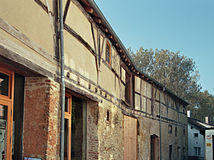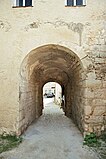Dollnstein Castle
| Dollnstein Castle | ||
|---|---|---|
|
Market fortification of Dollnstein with the castle hill. |
||
| Alternative name (s): | Tolenstein | |
| Castle type : | Höhenburg, summit location | |
| Conservation status: | Remains of the ring wall of the main castle dating back to the 11th century | |
| Standing position : | King, high nobility, bishop | |
| Construction: | Cuboid, quarry stone | |
| Place: | Dollnstein | |
| Geographical location | 48 ° 52 '31.5 " N , 11 ° 4' 22.4" E | |
| Height: | 400 m above sea level NHN | |
|
|
||
The castle Dollnstein , even Tolenstein called, is a hilltop castle on and around a prominent ledge about 400 m above sea level. NHN on the north bank of the Altmühl in Dollnstein in the Bavarian district of Eichstätt . The meaning of the place name has not been conclusively clarified, it may mean stone of tola . The upper castle can be described as a ruin , the lower castle is extremely well preserved.
history
The actual origins of Dollnstein Castle go back to the Carolingian era. By 1147 at the latest, the castle was owned by the Counts of Grögling , who later also named themselves after Dollnstein and finally after Hirschberg. In 1305 the Counts of Öttingen took possession of Dollnstein and his castle. In 1360 the Lords of Heideck bought the town and castle. In 1440, the Eichstätter Bishop Albrecht II von Hohenrechberg acquired, among other things, the Dollnstein Castle and Market for the Eichstätt Monastery , which they owned until 1802. Due to the secularization , the complex fell to Bavaria and in 1803 to the Grand Duke Ferdinand III. of Tuscany . In 1804 the castle was auctioned to Dollnstein citizens and the upper castle was demolished. The farm buildings in the outer bailey were used for residential purposes. Remnants of the upper castle were still standing until around 1850. Parts of the lower castle have been extensively renovated since 2006. The Altmühlzentrum was opened there in 2015 .
description
According to archaeological findings, the origin of the approximately 0.56 hectare main castle is one in the 9th / 10th. Weir system dating back to the 19th century, which was fortified with a wall built using a wood-earth construction method. This was probably built in place of an unpaved settlement from around 700. A first stone ring wall and a stone residential building as the core of the lower castle were built at this point in the 11th century . In the 12th century, the curtain wall was partially rebuilt and a chamber gate that is still preserved today was built on the south side of the castle. In a further construction phase during the 14th century, the curtain wall received, among other things, a crenellated wreath . In 1445 farm buildings and castle stables were added to the wall. From the lower castle still stand the castle gate and the farm buildings of the late Middle Ages , which are attached to the castle wall in a semicircle and built in the early Altmühl-Jura style , which are extremely valuable in terms of building history and are being extensively renovated. The "Altmühl Information Center Burg Dollnstein" is to be housed here. Little is known about the building history of the upper castle. Some of the wall remains that are still visible are clearly Romanesque, probably 12th century.
In November 2007, a ceramic vessel filled with silver coins and other precious metal objects from around 1370 was found during archaeological excavations. The background to the landfill is unknown.
The castle also included a lot of agricultural land, which was originally cultivated by a so-called building yard or Maierhof (located northwest of the castle). After the transition from the aristocratic castle to the purely official residence, the building yard was smashed into eight fiefdoms in 1459. In Dollnstein there was at least one armory until the 16th century.
literature
- Werner Meyer : Castles in Upper Bavaria - A manual . Verlag Weidlich, Würzburg 1986, ISBN 3-8035-1279-4 , p. 90 .
- Mathias Hensch : Tolunstein - The castle on the Altmühl. 1300 years of settlement continuity on Dollnsteiner Burgfelsen. To the results of the first excavation campaign in 2006 . In: The Jura House . No. 13, 2007/2008, ISSN 0948-5066 , pp. 93-108.
- Mathias Hensch: New archaeological findings in the former Dollnstein Castle. A preliminary report on the investigations in 2007 . In: The Jura House . No. 14, 2008/2009, ISSN 0948-5066 .
- Karl Zecherle (editor): Castles and palaces . Eichstätt district in the Altmühltal nature park. Ed .: District of Eichstätt. 2nd unchanged edition. Hercynia-Verlag, Kipfenberg 1987, DNB 944206697 , p. 10-11 .




